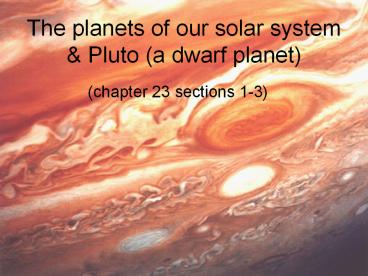The planets of our solar system - PowerPoint PPT Presentation
1 / 13
Title:
The planets of our solar system
Description:
The planets of our solar system & Pluto (a dwarf planet) (chapter 23 sections 1-3) Overview of our solar system There are two categories of planets in our solar ... – PowerPoint PPT presentation
Number of Views:230
Avg rating:3.0/5.0
Title: The planets of our solar system
1
The planets of our solar system Pluto (a dwarf
planet)
- (chapter 23 sections 1-3)
2
Overview of our solar system
- There are two categories of planets in our solar
system - Terrestrial Smaller, more dense, mostly rocky
metallic, thinner atmosphere due to smaller
gravitational force. - Jovian Larger, less dense, mostly gas ice,
thicker atmosphere due to larger gravitational
force.
3
Formation of our solar system
- Started as a nebula a cloud of dust gas
- It began to rotate and flatten, with heavier
particles moving toward the center of the disc - Planetesimals grew bigger collected more
material. - Radiation from the new sun pushed gas planets to
the outer regions, leaving rocky planets closer
in.
4
Mercury the smallest planet
- Closest to the sun
- No atmosphere
- Temperature range -279F 800F
- day 59 E. days
- Year 88 E. days
- No moons
5
Venus the veiled Planet
- Hot due to the greenhouse effect (887F)
- Atmosphere is 97 CO2
- Surface shaped by volcanic activity
- Day244 E.D.
- Year 225 E.D.
- No moons
6
Earth the living planet
- Only planet with liquid water on the surface
- Hydrosphere supports, maintains life
- Atmosphere shields radiation, burns up meteors
- 1 year 365 days 1 day 24 hours
7
Mars the red planet
- Polar icecaps have frozen water, CO2
- Largest volcano in solar system
- Thin atmosphere mostly CO2
- Year 693.5 E.D.
- Day 24.6 E. hours
- 10 the size of Earth
- Temp. -94F to -148F
- Has 2 moons
8
Jupiter Giant Gas Planet
- Mass is 2½ times the mass of all other planets
and moons combined - Possesses the Great Red Spot a giant cyclonic
storm
Year 12 E. years Day 10 hrs Moons 63 (and
counting) Temp - 200F
9
Saturn The Elegant Planet
Year 29.5 E. years Day 10 hrs Moons 56 Temp -
285F (top of clouds)
- Most prominent feature is the system of rings
consisting of individual particles of ice and rock
10
Uranus The Sideways Planet
- Unlike the other planets, Uranuss axis of
rotation lies nearly parallel with the plane of
its orbit about the sun - Has at least 9 distinct ring belts
Year 84 E. years Day 17 hrs Moons 27 Temp -
355F
11
Neptune The Windy Planet
- Winds exceeding 1000 km/hr (600 mi/hr) encircle
the planet - Year 165 E. years
- Day 16 hrs
- Moons 13
- Temp - 328F
12
Pluto Dwarf Planet
- Not considered a planet since has not cleared,
due to its weak gravitational attraction, the
neighborhood of its orbit of smaller objects
Year 248 E. years Day 6 days Moons 3 Temp -
387F
13
Whiteboard Review
- What is the smallest planet?
- Which planet has the longest day?
- Which planet has the most moons?

